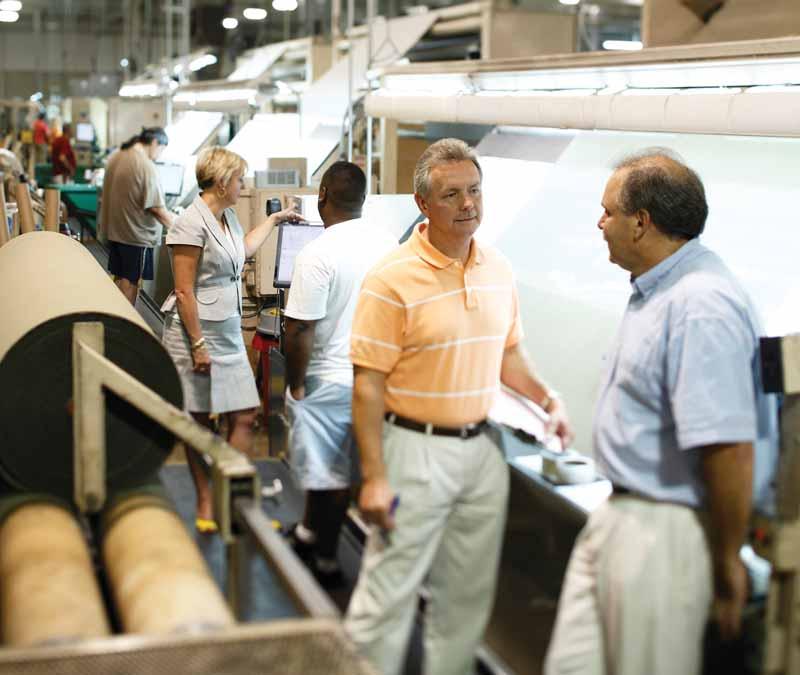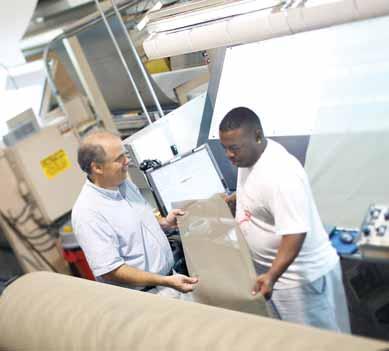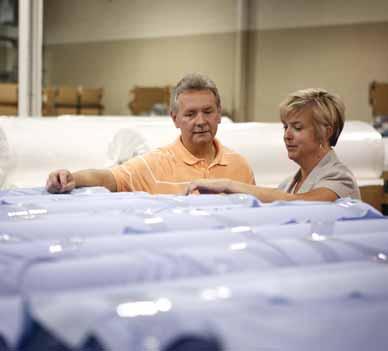
3 minute read
New Product Growth Exceeding
from Raven Issue No. 7
20 Percent
Any company you care to name will champion the importance of product innovation as the source of new business. Glen Raven Technical Fabrics, however, has taken this dedication to an entirely new level of importance, pegging 20 percent of its annual growth to new product development.
Advertisement
“We are talking about truly new products – products that have never been done before,” said Patti Bates, vice president of operations for Technical Fabrics. “Our 20 percent growth target does not include process improvements such as new yarns, colors or fabric styles. These are totally new products from initial concept to production and commercialization.”
Glen Raven Technical Fabrics has made tremendous strides in reinventing its business model over the past decade. Elements of this business unit had historically been focused on commissioned dying and finishing and commodity products. These businesses were very predictable and stable for many years, but off-shore competition intensifying in the 1990s made them unprofitable for U.S. production facilities. As a result, new product development focused on high-tech solutions has become the lifeblood of Technical Fabrics today.
Dr. Peter J. Brews, a business professor at UNC-Chapel Hill who has consulted with Glen Raven, described the challenge facing Technical Fabrics, and all U.S. companies in a lecture:
“Today, creativity is the only thing that really counts,” Brews said. “You invent a product or service that no one else has and you find markets and customers for it. By the time the competition has discovered what you have done, you have moved on to something new. It’s a game of constantly raising the stakes and changing the rules of the game.”
Bates describes Glen Raven’s product development process as a treadmill. As soon as you have something on the line, something else falls off, which demands replacement.
In order to thrive in this challenging environment, Glen Raven has a dedicated team of engineers at company headquarters who work closely with plant personnel. The product development process is highly disciplined, focused and collaborative.
“You can actually have too much activity in product development,” said Robert Earhart, Glen Raven product development manager. “New ideas come to us from many different sources and we begin by asking very specific questions. Who are the competitors? Why is this something we want to do? Does it make sense strategically? There are many specific things we ask ourselves before green lighting a development program, right down to costing. Many ideas never get that far, but when we decide to take on a project, we give it a total effort for success.”
Earhart and Sammy Rose, product development manager, work closely with Bates as a product development team at Glen Raven headquarters. They depend on support from several plant-level managers, including Tony Allen at the Burnsville plant and Lucy Scott in Statesville who assist with plant-level trials.
Because of its marketing discipline, Technical Fabrics has met its 20 percent growth goal for new products. Notable successes include GlenGuard® fire retardant work apparel fabrics, radar dispersion and HaloTech™ fabrics for the military, a growing automotive headliners business and fabrics for reverse osmosis. Technical Fabrics collaborated closely with its sister subsidiary, Glen Raven Custom Fabrics, on the creation of Firesist® HUV, a flame retardant fabric for awnings.
Glen Raven has extensive manufacturing and product development capabilities in-house, and the acquisition of John Boyle & Company in May of last year added in-house laminationand coating. Glen Raven also pursues collaboration with other manufacturers who offer expertise in fibers and fabrics.
The ideal product opportunity for Technical Fabrics has specific characteristics. It must be a completely new idea, not a “me too” derivative. If there is a development partner to share in the process all the better, as has been the case with Glen Raven’s growth in headliners. The ability of Glen Raven to create barriers to entry for a product also makes a development effort more attractive.
Specific cost estimates and pricing are essential to meeting Glen Raven’s return on investment requirements. The potential for long-term customer relationships add to the desirability of new products. Glen Raven is willing to follow an extended development cycle in cases where the potential warrants the investment.
“We focus on solutions, not products,” Bates said. “Long gone are the days when someone would bring in a piece of fabric and ask ‘can we make this?’ Our approach today is ‘what is the need in the market’ and ‘can we address that need with a profitable solution?’ In some instances, our role is not manufacturing at all, but working with a partner to take a new idea to market.”







